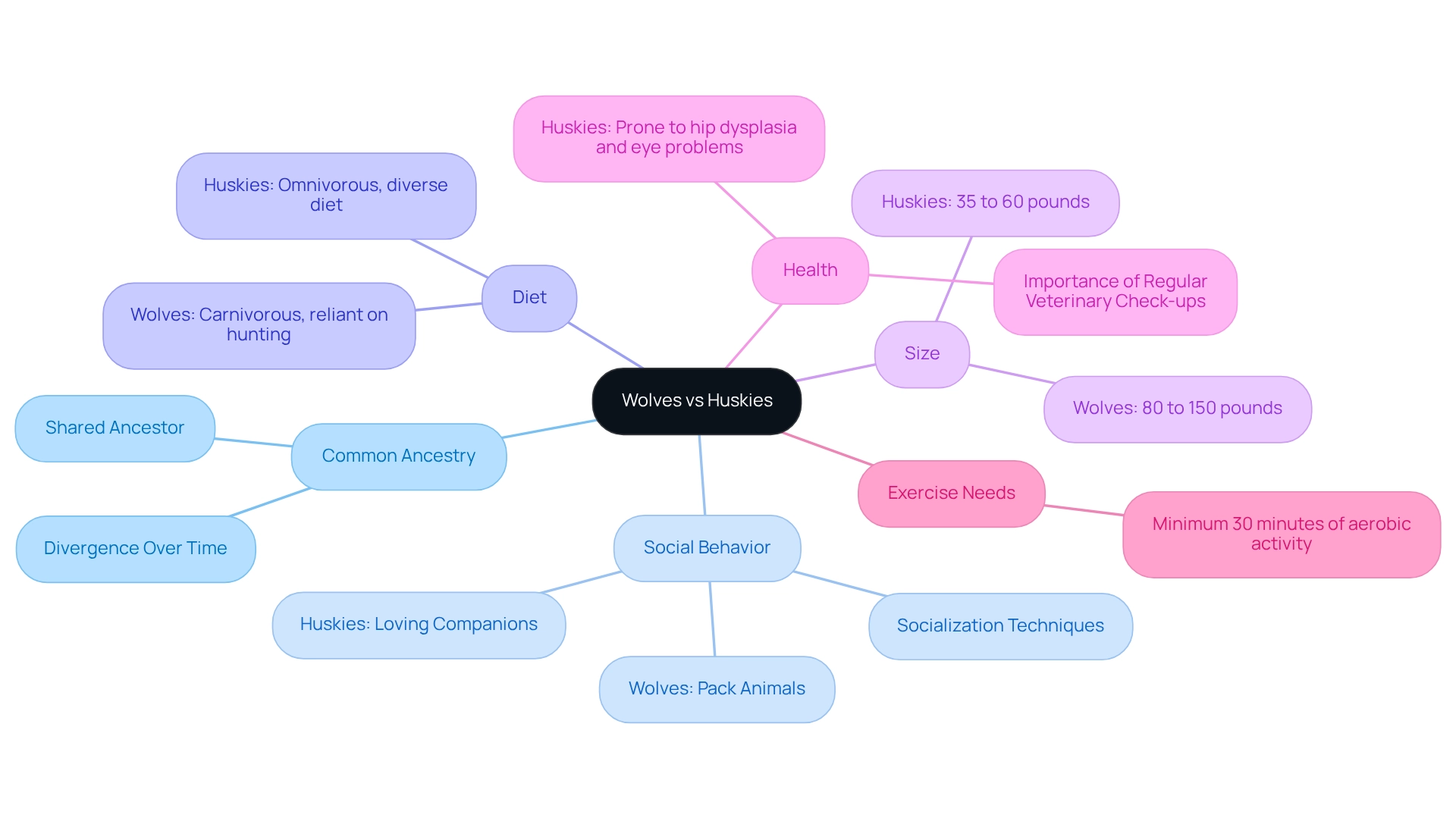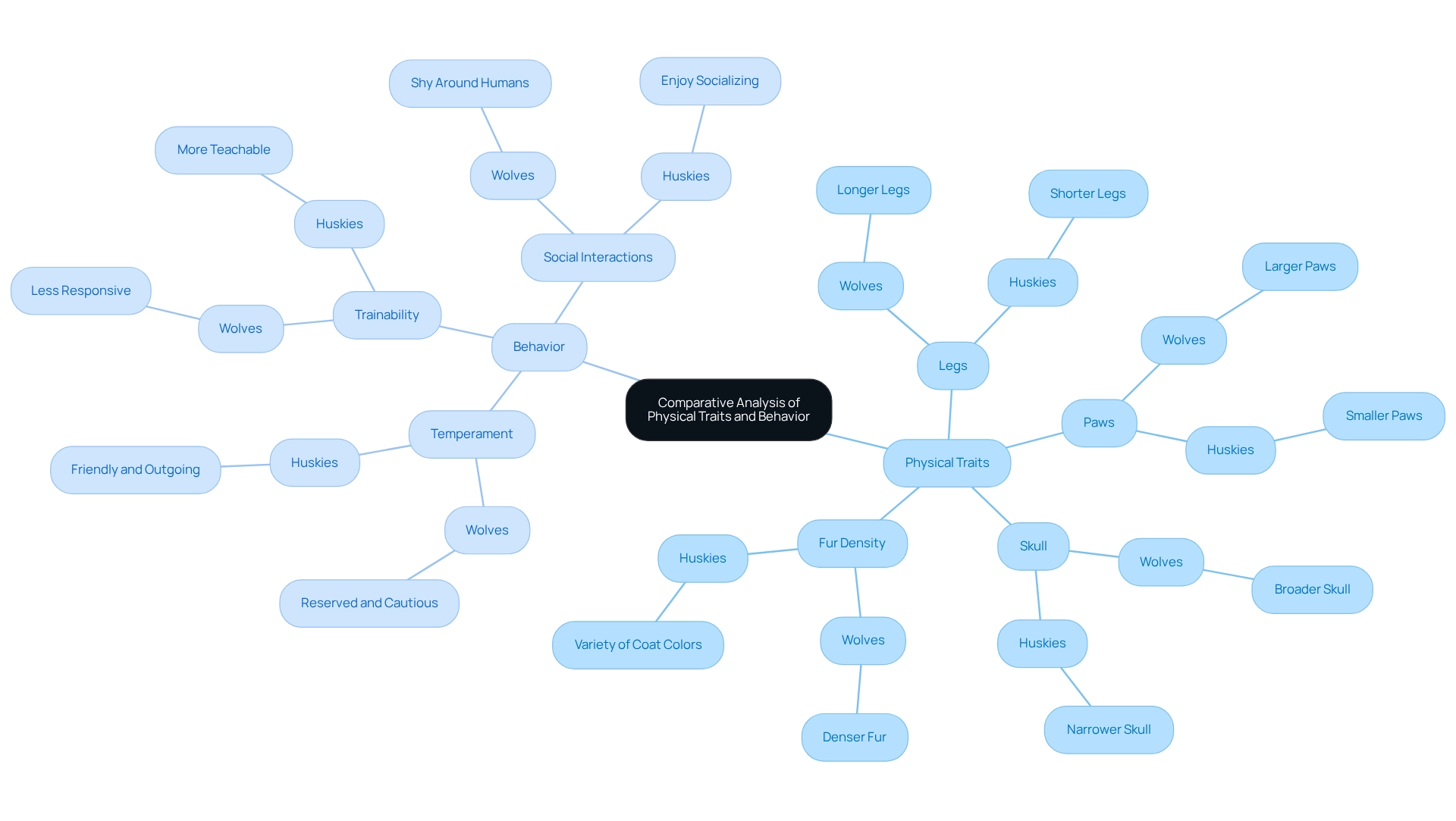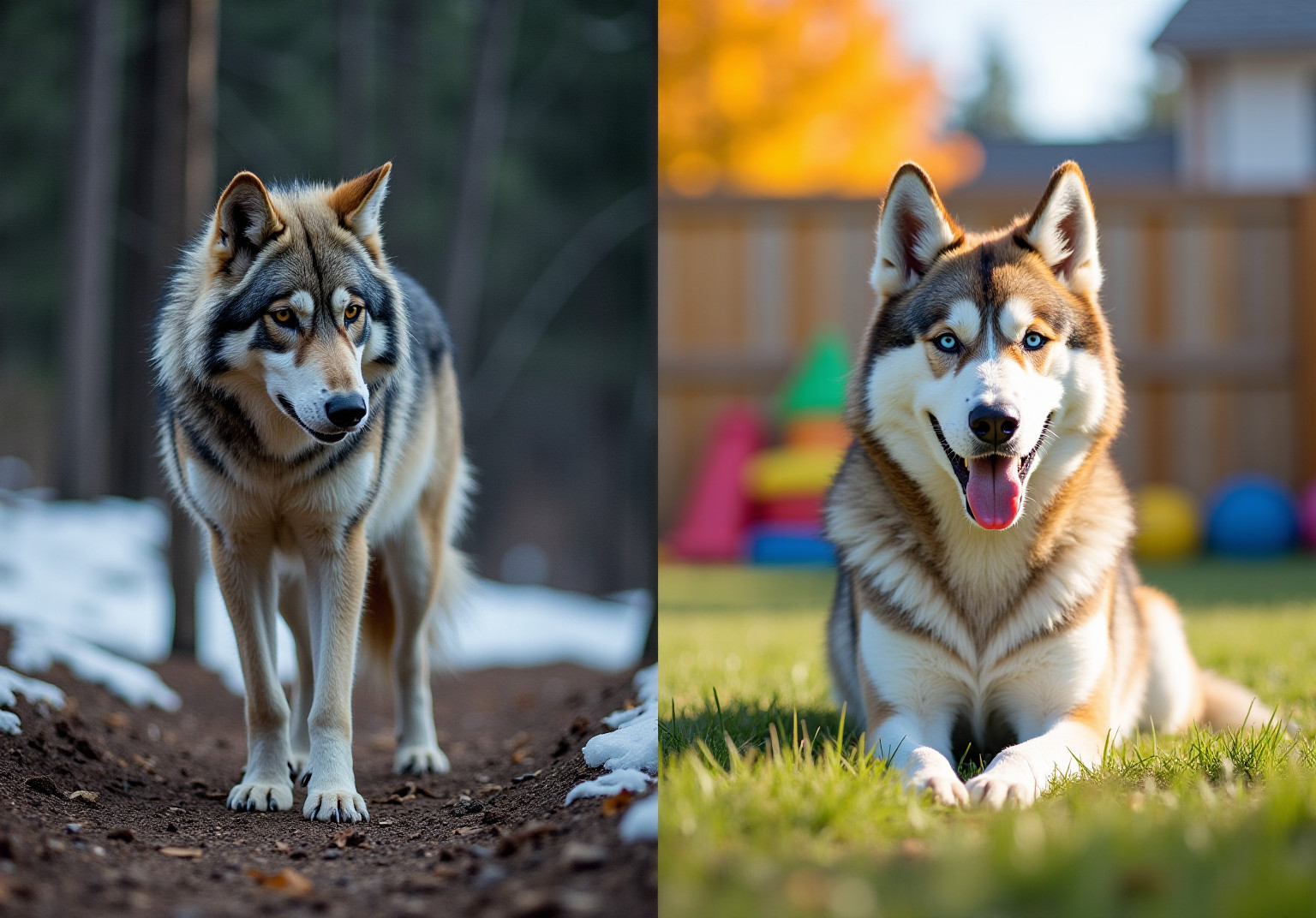Wolf vs Husky: Key Differences in Traits and Temperament
Overview
Understanding the key differences between wolves and Siberian Huskies is essential for any pet owner. Wolves are wild, larger, and more reserved creatures, while Huskies are domesticated, friendly, and thrive on social interaction and exercise. This distinction is crucial as it influences the care decisions we make for our furry family members.
At Adventure Den, we recognize that every pet has unique dietary needs, physical characteristics, and social behaviors. By detailing these aspects, we aim to support pet owners in making informed choices that nurture their beloved companions. Our insights into training responsiveness further empower you to create a loving and engaging environment for your pets.
Ultimately, our goal is to ensure that you feel confident and supported in your journey as a pet owner. We invite you to explore how Adventure Den can assist you in providing the best care for your furry friends, ensuring they lead happy and fulfilling lives.
Introduction
The captivating world of wolves and Siberian Huskies tells a fascinating story of divergence from a common ancestor, leading to distinct lifestyles and characteristics. While wolves embody the wild spirit of nature, thriving in complex social structures and exhibiting fierce independence, huskies have found their place as beloved companions, known for their playful demeanor and boundless energy.
This article explores the fundamental differences between these two remarkable species, focusing on their physical traits, behaviors, and temperaments.
For potential husky owners, understanding these nuances is crucial. It lays the groundwork for a fulfilling relationship with your furry family members, ensuring that you can meet the unique needs that come with husky ownership.
Fundamental Differences Between Wolves and Huskies
In the context of wolf vs husky, it is important to note that wolves (Canis lupus) and Siberian Huskies (Canis lupus familiaris) share a common ancestor but have diverged significantly over thousands of years. Understanding these differences is essential for anyone considering welcoming a new furry family member into their home. Wolves are untamed creatures that reside in groups, displaying intricate social systems. In contrast, Siberian sled dogs are loving companions, raised for their warmth and hard work.
When it comes to diet, wolves are primarily carnivorous, relying on hunting for nourishment. Siberian Huskies, however, are omnivorous and thrive on a diverse diet, making their care a bit more flexible. Additionally, it’s important to note that wolves are generally larger, with adult males weighing between 80 to 150 pounds, while sled dogs typically weigh between 35 to 60 pounds.
Energetic breeds like Siberian Huskies require at least 30 minutes of intense aerobic activity most days of the week—ideally every day—to maintain their well-being and joy. Socialization methods can greatly assist adult dogs or rescues in feeling at ease with new individuals and circumstances. This highlights the importance of education and interaction in their growth, ensuring they feel secure and loved.
While Siberian Huskies are generally healthy, they can be prone to certain health issues, including hip dysplasia and eye problems. Regular veterinary check-ups are essential to keep your furry friend healthy and happy. Comprehending these essential differences in the wolf vs husky comparison not only guides prospective owners in their methods of care and training but also helps in making necessary lifestyle modifications to meet the specific needs of these wonderful dogs. Embrace the journey of nurturing your pet with love and understanding, and they will surely thrive.

Comparative Analysis of Physical Traits and Behavior
These remarkable animals are physically designed for endurance and power, showcasing longer legs, larger paws, and a broader skull compared to sled dogs. Their denser fur is perfectly suited for extreme climates, while sled dogs display a delightful variety of coat colors and patterns.
Behaviorally, these canines tend to be more reserved and cautious, often exhibiting shyness around humans. In contrast, huskies are celebrated for their friendly and outgoing nature. When considering the wolf vs husky, it’s clear that Huskies tend to be more teachable due to their domestication, responding positively to training methods that utilize encouragement, while wild canines may be less responsive and more unpredictable.
As we explore specific traits such as size, coat, and behavior patterns, we aim to provide a comprehensive comparison that addresses your concerns about pet care. Recent studies indicate that Siberian Huskies share a genetic connection with canines, having diverged from their ancestral lineage approximately 35,000 years ago. Understanding these physical and behavioral characteristics is essential for pet guardians and trainers, as it informs how to approach training and care for your furry family members.
The ongoing research into canid populations also illuminates their ecological roles and behaviors, further distinguishing them from their domesticated counterparts. As Nicole, an experienced author, emphasizes, grasping these differences is crucial for ensuring the happiness and safety of both pets and their owners. Let’s nurture this understanding together, ensuring a loving and supportive environment for your beloved pets.

Temperament Comparison: Wolves vs. Huskies
Canines are cherished for their strong pack instincts and social hierarchies, which shape their interactions with fellow members of their species and their environment. While they may appear more aloof and cautious around humans, often avoiding direct contact, it’s essential to understand their perspective. Research shows that since 2008, the average density of wolves has stabilized at about 39 wolves per 1000 km, reflecting their intricate social structures and territorial behaviors. In contrast, dogs are highly social animals that thrive on human interaction and companionship. They bring joy with their playful and affectionate nature, often earning the nickname ‘clowns’ for their delightful, mischievous antics. Although both species exhibit intelligence, the breeds known for their friendly demeanor are particularly eager to please their owners, making them wonderful family pets.
Expert opinions shed light on these temperament differences. Kira Cassidy, a research associate with the Yellowstone Canine Project, notes that these animals adopt a cautious stance towards unfamiliar humans, demonstrating their innate survival instincts. This stands in stark contrast to sled dogs, whose social behavior allows them to seamlessly integrate into family environments, showcasing loyalty and affection towards their human companions.
Furthermore, the case study on the recolonization of gray canines in Wisconsin illustrates the complexities of their behavior and social structures in a real-world context. This example underscores the effectiveness of conservation efforts while highlighting the challenges posed by fluctuating legal protections. In summary, understanding the temperament differences in the wolf vs husky comparison is vital for prospective pet guardians. These differences significantly influence training, socialization, and overall compatibility with human families. By comprehending these characteristics, you can make informed decisions about the best match for your furry family members, ensuring a nurturing environment for all.

Implications for Pet Ownership: Choosing a Husky
Choosing a Siberian breed as a pet comes with unique responsibilities and considerations that every prospective owner should understand. Huskies are celebrated for their vibrant energy and keen intelligence, which means they require plenty of exercise and mental stimulation. It’s important to note that these dogs thrive on at least 1-2 hours of vigorous activity each day to keep them physically and mentally healthy. Their natural inclination to escape further emphasizes the need for secure fencing and attentive supervision, ensuring they stay safe and sound.
Socialization plays a crucial role in their development, as these dogs truly flourish in environments where they can interact with both people and other canines. Prioritizing early socialization is essential, as it significantly influences their behavior and adaptability. Grooming is another important aspect; these dogs shed quite a bit, especially during seasonal changes, so regular brushing is necessary to maintain their thick double coat.
For new caregivers of this breed, practical advice includes establishing a consistent routine that incorporates positive reinforcement techniques. Engaging in activities like agility exercises or obedience classes can greatly enhance their mental engagement and strengthen the bond between you and your furry family member. Additionally, creating a structured daily schedule that includes physical activity, playtime, and relaxation will help nurture a balanced relationship.
At Adventure Den, we offer customized daycare and training programs specifically designed for high-energy breeds, ensuring they receive the exercise and social interaction they need. Real-life experiences from our caretakers highlight both the joys and challenges of having a sled dog breed. Many owners share that, despite their spirited temperament, dogs such as the wolf vs husky are truly wonderful companions who bring immense joy to their lives. Our expert advice underscores the importance of understanding these responsibilities, ensuring a fulfilling and rewarding experience with your husky. Adventure Den is dedicated to supporting you on this journey, creating a nurturing environment for your beloved pet.

Conclusion
The exploration of the differences between wolves and Siberian Huskies reveals significant insights into their unique characteristics, behaviors, and needs. Wolves, as wild animals, exhibit complex social structures and a strong instinct for survival. In contrast, Siberian Huskies have been bred for companionship, displaying an affectionate and playful nature. Understanding these distinctions is crucial for potential husky owners, as it informs their approach to care, training, and the overall lifestyle adjustments necessary for the breed.
Physically, wolves and huskies differ in size, strength, and adaptability to their environments. Wolves are larger and built for endurance, whereas huskies are more agile and friendly, making them suitable family pets. This behavioral contrast is further emphasized by their social tendencies; huskies exhibit a strong desire for human interaction compared to the more reserved nature of wolves.
For those considering adding a husky to their family, it is essential to recognize the responsibilities that come with ownership. Huskies require ample exercise, mental stimulation, and socialization to thrive. By establishing a structured routine and engaging in activities that cater to their energetic nature, owners can foster a fulfilling relationship with their huskies. Ultimately, understanding the nuances of these remarkable breeds not only enhances the bond between humans and their furry family members but also contributes to the overall well-being of both species.
Frequently Asked Questions
What are the main differences between wolves and Siberian Huskies?
Wolves are untamed creatures that live in groups with complex social systems, while Siberian Huskies are domesticated companions bred for warmth and hard work.
How does the diet of wolves differ from that of Siberian Huskies?
Wolves are primarily carnivorous and rely on hunting for food, whereas Siberian Huskies are omnivorous and thrive on a diverse diet.
What is the size difference between wolves and Siberian Huskies?
Adult male wolves typically weigh between 80 to 150 pounds, while Siberian Huskies usually weigh between 35 to 60 pounds.
How much exercise do Siberian Huskies need?
Siberian Huskies require at least 30 minutes of intense aerobic activity most days of the week, ideally every day.
What are some common health issues that Siberian Huskies may face?
Siberian Huskies can be prone to health issues such as hip dysplasia and eye problems, making regular veterinary check-ups essential.
Why is socialization important for Siberian Huskies?
Socialization helps adult dogs or rescues feel comfortable with new people and situations, which is crucial for their growth and overall well-being.
What should prospective Husky owners consider before bringing one home?
Understanding the differences in care, training, and lifestyle modifications needed for Siberian Huskies compared to wolves is essential for prospective owners.







